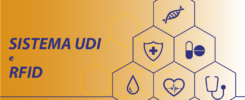Among the various types of RFID readers, the desktop is perhaps the most underestimated category and least talked about.
It is therefore time to do justice to these readers and give them the value they deserve!!
Below I will explain, in short, the main potential that these devices hide!
Let’s start by asking…
What is a desktop RFID reader?
If you already know the answer, go to the next question, otherwise keep reading
A desktop (or integrated) RFID reader is powered and controlled directly via a USB cable, thus enabling quick and easy reading/writing of the tag in a desktop environment.
The reading distance usually ranges from 10 cm for HF devices, up to one and a half meters for UHF ones.
In practice, they can act as input devices. So, if the tag gets close to the reader, some actions are triggered on the computer, to which the reader is connected.
The distinctive feature is the integrated antenna, which allows a much easier installation than fixed readers.
Another quality are the compact dimensions. This combined with, the low cost and interesting basic features, makes desktop RFID readers a good choice to consider for those who need a small, cheap, and not too powerful reader.
To give you an idea of the capabilities of a desktop reader, you can find a list of the most common applications below.
Where can the desktop RFID reader be used?
Point of Sale: in retail environments, it is perfect to keep on your desk or counter to capture readings of items leaving the store;
Document management: in certain environments, such as a law firm, there is a need to manage many documents. Thanks to the use of the desktop reader, instead of spending hours or even days, finding resources becomes quick and easy. There is complete certainty of where the necessary documentation is located !!;
Programming Station: used to program RFID tags. It consists of a desktop RFID reader that reads, programs, or updates the information stored in the transponder;
Access control: the desktop RFID reader is ideal in this field, where high accuracy and compact dimensions are appreciated. It allows flows to be monitored and controlled in certain circumstances. Specifically, this type of reader can be used to monitor access to a given building (such as a museum, a hospital, a school) and/or in premises or restricted areas of a facility (such as a laboratory, a warehouse). Access control is fundamental to avoid the entry of unaccredited person, or to know the presence or absence of person in case of emergency.
Why should you choose this type of RFID reader?
Unexpensive
USB interface
Fast data transfer
Small size
Easy to use
Well, considering what has been written, the desktop RFID reader is a good compromise in terms of quality-price!!
If the list of its potential and its uses was not enough for you and you want to know even more…no panic we are here on purpose!!!
Contact us by email at info@tertiumtechnology.it or visit our website!!!

